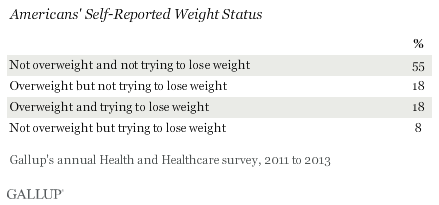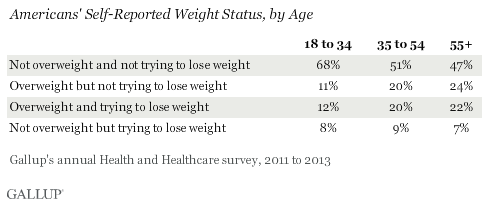WASHINGTON, D.C. -- A majority of Americans (55%) say they are neither overweight nor trying to lose weight, despite a recent study by the Institute for Health Metrics and Evaluation (IHME) that found two-thirds of Americans are overweight or obese.

As for Americans who report being overweight, equal percentages say they are overweight and trying to lose weight (18%) or are overweight and not trying to lose weight (18%).
These data are aggregated from Gallup's Health and Healthcare surveys from 2011 through 2013. The annual survey asks Americans about their current weight status and whether they are seriously trying to lose weight.
It is important to note that the Gallup data are based on self-descriptions of Americans' weight status from telephone interviews. Gallup-Healthways research, also conducted via telephone, takes a different approach by calculating Body Mass Index (BMI) scores based on respondents' self-reported height and weight. Another technique used to measure obesity involves in-person interviewing in which interviewers take actual height and weight measurements of study participants. These different measurement methods may result in differing estimates of the percentage of Americans who are overweight or obese.
Women, Older Americans More Likely to Say They're Trying to Lose Weight
Overall, 60% of men and 50% of women report that they are neither overweight nor trying to lose weight. Women, in general, are more likely to say they are "very" or "somewhat" overweight compared with men. Further, 21% of women say they are overweight and trying to lose weight, significantly higher than the 15% of men who say the same.

Additionally, 10% of women say they are not overweight but are currently trying to lose weight, considerably more than the 6% of men who say the same.
Younger adults are significantly more likely than older adults to express contentment with their current weight. Among Americans aged 18 to 34, 68% state that they are neither overweight nor trying to lose weight, while 12% say they are overweight and trying to lose weight.
Just under half of Americans aged 55 and older, 47%, say they are neither overweight nor trying to lose weight, while 22% report that they are overweight and trying to lose weight.

Implications
These data highlight the importance of perception in the battle to fight obesity in the U.S. Though several recent studies -- including the global analysis released in May by IHME -- have documented that two-thirds of Americans are overweight or obese, less than 40% of American adults characterize themselves as either very or somewhat overweight. Further, previous Gallup research has shown that men are more likely to be overweight or obese than women when using BMI as a metric, yet these findings indicate that women are more likely to characterize themselves as overweight.
This discrepancy may suggest that addressing the obesity crisis in America must first start by convincing overweight Americans that they are indeed overweight.
Survey Methods
Results for this Gallup poll are based on telephone interviews conducted on the annual Gallup Health and Healthcare surveys for 2011, 2012, and 2013, with a combined random sample of 3,066 adults, aged 18 and older, living in all 50 U.S. states and the District of Columbia.
For results based on the total sample of national adults, the margin of sampling error is ±2 percentage points at the 95% confidence level.
Interviews are conducted with respondents on landline telephones and cellular phones, with interviews conducted in Spanish for respondents who are primarily Spanish-speaking. Each sample of national adults includes a minimum quota of 50% cellphone respondents and 50% landline respondents, with additional minimum quotas by time zone within region. Landline and cellular telephone numbers are selected using random-digit-dial methods. Landline respondents are chosen at random within each household on the basis of which member had the most recent birthday.
Samples are weighted to correct for unequal selection probability, nonresponse, and double coverage of landline and cell users in the two sampling frames. They are also weighted to match the national demographics of gender, age, race, Hispanic ethnicity, education, region, population density, and phone status (cellphone only/landline only/both, and cellphone mostly). Demographic weighting targets are based on the most recent Current Population Survey figures for the aged 18 and older U.S. population. Phone status targets are based on the most recent National Health Interview Survey. Population density targets are based on the most recent U.S. census. All reported margins of sampling error include the computed design effects for weighting.
In addition to sampling error, question wording and practical difficulties in conducting surveys can introduce error or bias into the findings of public opinion polls.
For more details on Gallup's polling methodology, visit www.gallup.com.
